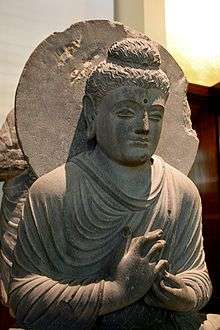Seated Buddha from Gandhara
|
Seated Buddha from Gandhara on display in the British Museum | |
| Material | schist (stone) |
|---|---|
| Size |
Height: 95 cm |
| Period/culture | c. 2nd - 3rd Century AD |
| Place | Jamal Garhi, Gandhara, Pakistan |
| Present location | Room 33, British Museum, London |
The Seated Buddha from Gandhara is an early statue of the Buddha discovered at the site of Jamal Garhi in ancient Gandhara in modern-day Pakistan, that dates to the 2nd or 3rd century AD. It is now in room 33 of the British Museum.[1] Statues of the "enlightened one" were not made until the 1st century CE, before that Buddha was represented by aniconic symbols such as his footprint.[2] Like other Gandharan, or Greco-Buddhist art, the statue shows influence from Ancient Greek art, as the region had been part of the Greco-Bactrian Kingdom established by Alexander the Great.
Description
The statue was carved in schist, allowing very fine detail, even down to showing the fingernails. The pose, which was to become one of a number of standard ones, shows Buddha as a teacher setting the wheel of Dharma in motion (Dharmachakra Mudrā). Buddha did this following his enlightenment and after delivering his first sermon at the deer park at Sarnath[1] near Varanasi in Uttar Pradesh. The statue was made in the 2nd or 3rd century and although Buddha lived in the 4th century before Christ this is still a quite early statue. Statues of the "enlightened one" were not made until the 1st century AD. For the first four hundred years after his death Buddha was represented by symbols alone such as his footprint.[2]
This statue was used as the inspiration of a BBC Radio 4 programme in the series called A History of the World in 100 Objects in May 2010. The programme discussed the change that allowed Buddha to be represented by a statue instead of as previously by symbols alone.[3]
The figure of the Buddha is shown on a cushion on a throne or platform. On the front of the throne there are much smaller figures of a bodhisattva with a turban and halo, flanked by kneeling figures of a male and female probably representing donor portraits of a couple who paid for the statue.[4]
Similar statues
There is a similar statue carved from black schist at Yale University Art Gallery[5] Another comparable statue was sold by Christie's in September 2009 for $218,500. That statue dated from the same time and place and was 26 inches high.[6] These Buddhas are widely considered to be the rarest of all Buddhist sculptures and despite iconoclasm, they can be found in the museums of France, Germany, Japan, Korea, China, India, and Afghanistan as well as those still remaining in Pakistan.[7]
Gallery
 Another view of the seated Buddha in the British Museum
Another view of the seated Buddha in the British Museum Seated Buddha, Gandhara, Berlin Museum.
Seated Buddha, Gandhara, Berlin Museum.
See also
References
- 1 2 Seated Buddha from Gandhara, British Museum Highlights, accessed July 2010
- 1 2 Seated Buddha, History of the World in 100 Objects, BBC, accessed July 2010
- ↑ Seated Buddha from Gandhara, BBC Radio 4, accessed July 2010
- ↑ Collection database, British Museum
- ↑ Seated Buddha, CalStateLA.edu, accessed July 2010
- ↑ A gray schist figure of a seated Buddha, Christies.com, 2009, accessed July 2010
- ↑ Gandhara Civilization, Heritage.gov.pk, accessed July 2010
| Preceded by 40: Empress Pepper Pot |
A History of the World in 100 Objects Object 41 |
Succeeded by 42: Gold coin of Kumaragupta I |

